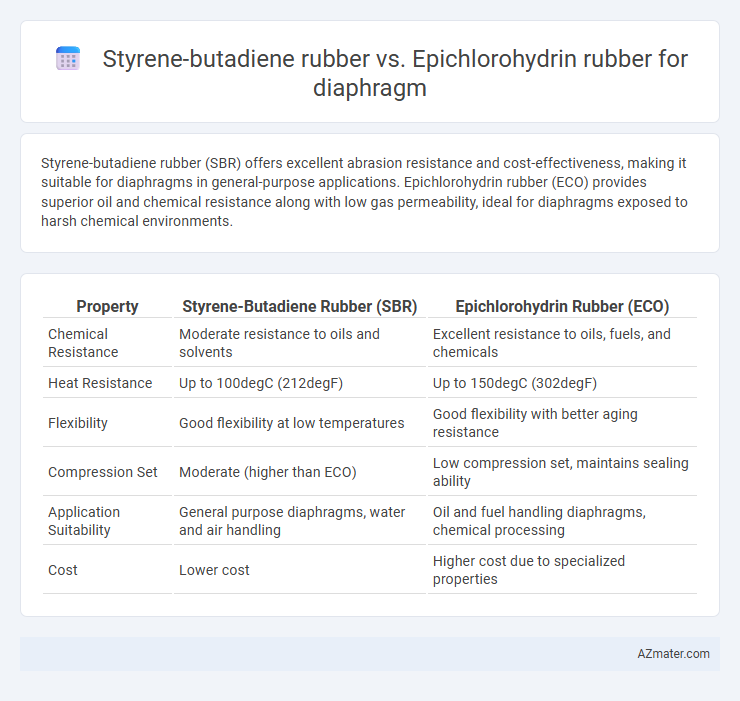Styrene-butadiene rubber (SBR) offers excellent abrasion resistance and cost-effectiveness, making it suitable for diaphragms in general-purpose applications. Epichlorohydrin rubber (ECO) provides superior oil and chemical resistance along with low gas permeability, ideal for diaphragms exposed to harsh chemical environments.
Table of Comparison
| Property | Styrene-Butadiene Rubber (SBR) | Epichlorohydrin Rubber (ECO) |
|---|---|---|
| Chemical Resistance | Moderate resistance to oils and solvents | Excellent resistance to oils, fuels, and chemicals |
| Heat Resistance | Up to 100degC (212degF) | Up to 150degC (302degF) |
| Flexibility | Good flexibility at low temperatures | Good flexibility with better aging resistance |
| Compression Set | Moderate (higher than ECO) | Low compression set, maintains sealing ability |
| Application Suitability | General purpose diaphragms, water and air handling | Oil and fuel handling diaphragms, chemical processing |
| Cost | Lower cost | Higher cost due to specialized properties |
Introduction to Diaphragm Materials
Diaphragm materials for industrial applications demand exceptional chemical resistance and durability to withstand harsh environments. Styrene-butadiene rubber (SBR) offers excellent abrasion resistance and cost-effectiveness but has limited resistance to oils and chemicals, making it suitable for general-purpose diaphragms. In contrast, epichlorohydrin rubber (ECO) provides superior resistance to fuel, oil, and ozone, making it ideal for diaphragms exposed to aggressive chemicals and harsh conditions.
Overview of Styrene-Butadiene Rubber (SBR)
Styrene-Butadiene Rubber (SBR) is a synthetic elastomer widely used in diaphragm applications due to its excellent abrasion resistance, good aging stability, and cost-effectiveness. It offers moderate oil and chemical resistance, making it suitable for general-purpose diaphragms in automotive, industrial, and consumer goods sectors. Compared to Epichlorohydrin rubber, SBR provides enhanced durability in dry environments but may exhibit lower performance in exposure to oils and fuels.
Overview of Epichlorohydrin Rubber (ECO)
Epichlorohydrin rubber (ECO) offers excellent resistance to oils, fuels, and chemical exposure, making it ideal for diaphragm applications requiring durability and flexibility under harsh conditions. ECO exhibits superior resistance to ozone, weathering, and low-temperature flexibility compared to Styrene-butadiene rubber (SBR), enhancing diaphragm longevity in automotive and industrial systems. Its balanced chemical resistance and mechanical properties enable reliable sealing performance in fuel systems, hydraulic components, and refrigeration units.
Chemical Resistance: SBR vs ECO
Styrene-butadiene rubber (SBR) offers moderate chemical resistance, performing well against abrasion but showing susceptibility to oils, fuels, and chemicals such as aromatic hydrocarbons and ketones. Epichlorohydrin rubber (ECO) exhibits superior chemical resistance, particularly against fuels, oils, ozone, and weathering, maintaining flexibility in harsh environments where SBR tends to degrade. ECO's enhanced resistance to a wide range of chemicals makes it more suitable for diaphragm applications requiring durability in aggressive chemical exposure.
Mechanical Properties Comparison
Styrene-butadiene rubber (SBR) offers excellent abrasion resistance and moderate tensile strength, making it suitable for diaphragms requiring durability under mechanical stress. Epichlorohydrin rubber (ECO) provides superior oil resistance, enhanced flexibility, and better resistance to compression set, maintaining mechanical integrity over extended cycles. While SBR excels in wear resistance, ECO outperforms in elasticity and chemical stability, influencing diaphragm selection based on operational environment and load demands.
Temperature Resistance and Performance
Styrene-butadiene rubber (SBR) offers moderate temperature resistance, typically up to 100degC, making it suitable for general diaphragm applications requiring good abrasion resistance and low cost. Epichlorohydrin rubber (ECO) excels with higher temperature resistance, often sustaining performance up to 150degC, and superior oil, chemical, and ozone resistance, which enhances diaphragm durability in demanding environments. For diaphragms exposed to elevated temperatures and aggressive chemicals, epichlorohydrin rubber provides better long-term performance and stability compared to styrene-butadiene rubber.
Aging and Ozone Resistance
Styrene-butadiene rubber (SBR) exhibits moderate aging resistance but is susceptible to ozone degradation, limiting its lifespan in ozone-rich environments. Epichlorohydrin rubber (ECO) demonstrates superior resistance to aging and ozone exposure due to its saturated polymer backbone and chlorine content, enhancing durability and performance in diaphragm applications. Choosing ECO rubber ensures prolonged operational integrity and reduced maintenance in ozone-prone conditions.
Cost Implications and Availability
Styrene-butadiene rubber (SBR) offers a cost-effective solution with widespread availability, making it suitable for diaphragm applications where budget constraints are critical. Epichlorohydrin rubber (ECO) tends to have higher material costs due to its specialized chemical properties, but provides superior resistance to oils and solvents, which may justify the investment in high-performance environments. Availability of SBR is generally more consistent globally, whereas ECO's supply can be limited and more variable depending on regional chemical manufacturing capacities.
Common Applications in Diaphragm Manufacturing
Styrene-butadiene rubber (SBR) is widely used in diaphragm manufacturing for automotive applications, industrial seals, and water pump diaphragms due to its excellent abrasion resistance and good chemical stability. Epichlorohydrin rubber (CO) excels in applications requiring superior resistance to oil, fuel, and ozone, making it ideal for diaphragms in fuel systems, hydraulic equipment, and refrigeration compressors. Both materials offer unique benefits, with SBR favored for durability in mechanical environments and Epichlorohydrin rubber preferred in chemically aggressive or oil-exposed conditions.
Choosing the Right Rubber for Diaphragm Use
Styrene-butadiene rubber (SBR) offers excellent abrasion resistance and cost-effectiveness, making it suitable for diaphragms exposed to mechanical wear and general-purpose sealing. Epichlorohydrin rubber provides superior oil and chemical resistance, low permeability, and good retention of flexibility at low temperatures, ideal for diaphragms in automotive and industrial fluid handling applications. Selecting the right rubber depends on the diaphragm's exposure to chemicals, temperature range, and mechanical stress, with epichlorohydrin preferred for aggressive environments and SBR for general durability and affordability.

Infographic: Styrene-butadiene rubber vs Epichlorohydrin rubber for Diaphragm
 azmater.com
azmater.com